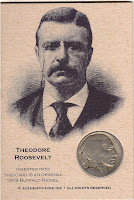My earliest memory of learning about Theodore Roosevelt was going with the Cub Scouts to visit Sagamore Hill, his estate in Oyster Bay, New York. Roaming through Sagamore Hill with my fellow Scouts brought fascinating images of Roosevelt’s trophies from his various hunts. The skins, heads, and an ashtray made from an elephant’s hoof made quite an impression on this group of 7-8 year olds.
A special memory was of the bathrooms. Aside from looking very primitive compared to what we have in our homes even in the mid-1960s, but our Cub Master, who was also my best friend’s father, was a plumber. At times, he was worked for New York City as a plumbing inspector. We had fun poking fun at him using the facilities at Sagamore Hill as a background!
When I learned more about United States history in high school, I read more about the life and presidency of Teddy Roosevelt. I was impressed with his background of working through his health issues, was fascinated to read of his life in the Badlands in South Dakota, and interested to read about his political life as someone who demonstrated a great regard for the law and someone who wanted to make things better. Although I was not as physical as Roosevelt, his principled stance made an impression on me.
Before returning to collecting, I read The Rise of Theodore Roosevelt by Edmund Morris. It was not the easiest read because Morris used the late Victorian writing style that was popular during Roosevelt’s life. Once I became used to the style, Morris brings the reader along with Roosevelt into the mud of the Badlands, the halls of the New York legislature, as one of the police chiefs of New York City, Governor of New York, Secretary of the Navy, and Vice President. Through Morris’s words, it was like riding that freight train what was Theodore Roosevelt.
I returned to collecting in 2001 following the death of my first wife. During a particular spending spree, I bought Morris’s second volume, Theodore Rex. Although I never finished this book—only because of timing—my interest in Roosevelt continued to grow.
Then I learned about Roosevelt’s “Pet Crime.” I learned how Roosevelt conspired with Augustus Saint Gaudens to improve U.S. coin design. I learned how Roosevelt was influenced by immigrant Victor David Brenner to have the U.S. Mint issue the Lincoln Cent. I learned how the seeds of his “Pet Crime” lead to what has been called a renaissance of U.S. coinage.
 To say I am a sucker for Theodore Roosevelt memorabilia would be an understatement. Although I do not have many pieces, finding cool items is always a thrill. Imagine how my eyes lit up when I found a Theodore Roosevelt card with a 1919 Buffalo Nickel. I did not know much about it, but I had to buy it. The final cost was not that expensive, but it was so cool that I did not care.
To say I am a sucker for Theodore Roosevelt memorabilia would be an understatement. Although I do not have many pieces, finding cool items is always a thrill. Imagine how my eyes lit up when I found a Theodore Roosevelt card with a 1919 Buffalo Nickel. I did not know much about it, but I had to buy it. The final cost was not that expensive, but it was so cool that I did not care.
When the card arrived, I was a little disappointed in that the card was modern and the nickel was very worn. I can change the nickel since 1919 Buffaloes are not that expensive. But I had to find out more about the card.
After asking around, I found that the company, Authenticated Ink, is an autograph collecting company that issued these cards in 2008 as a promotion. Authenticated Ink printed cards of sports and historical figures that included coins from the era of the person depicted on the card. I have had problems contacting Authenticated Ink (emails have not been returned), but sources tell me that there were not many of these cards issued.
It is a very cool collectible and has been added to my “oh neat” collection.


2 Comments